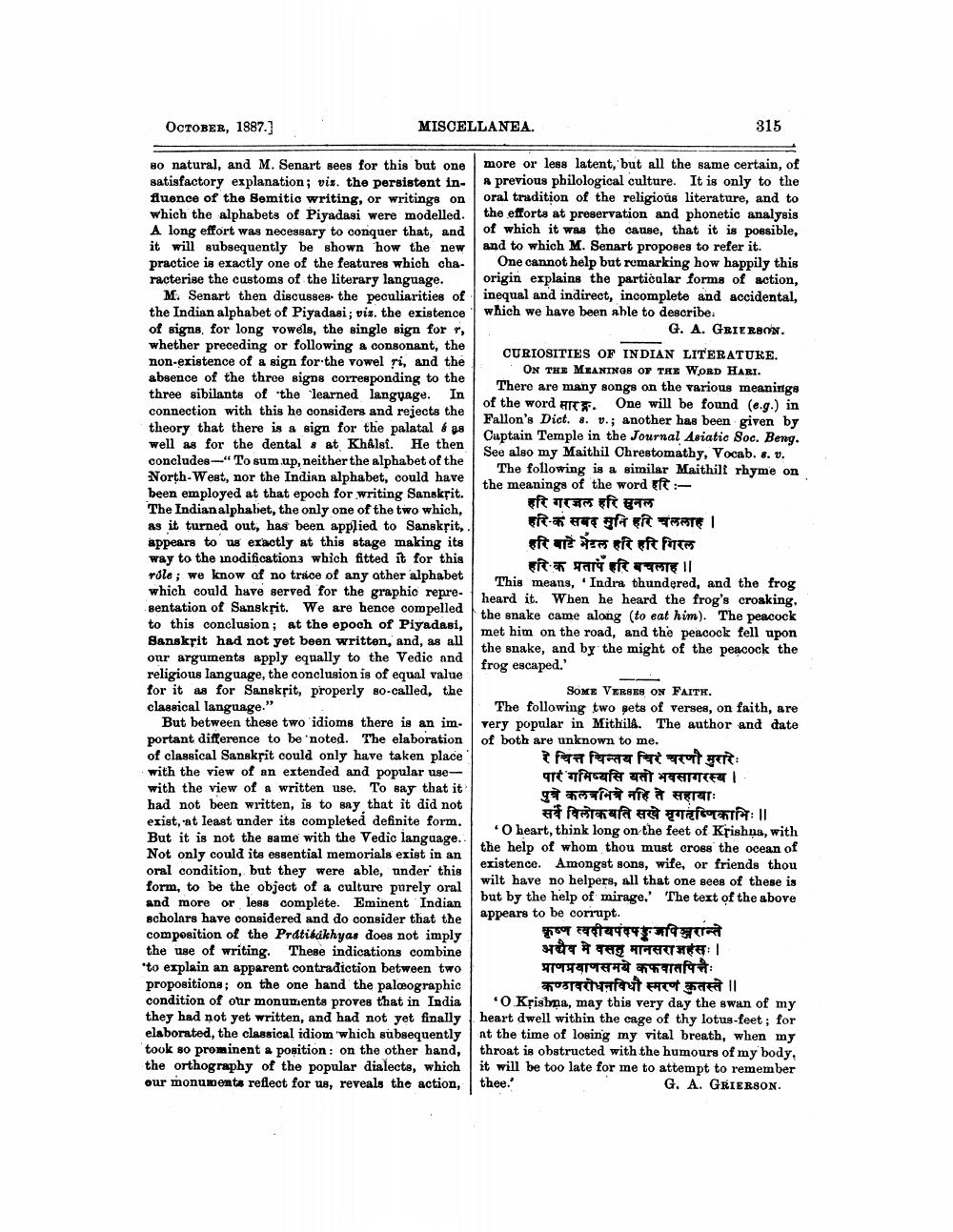________________
OCTOBER, 1887.)
MISCELLANEA.
315
80 natural, and M. Senart sees for this but one satisfactory explanation; vix. the persistent influence of the Semitic writing, or writings on which the alphabets of Piyadasi were modelled. A long effort was necessary to conquer that, and it will subsequently be shown how the new practice is exactly one of the features which characterise the customs of the literary language.
M. Senart then discusses the peculiarities of the Indian alphabet of Piyadasi; viz. the existence of signs, for long vowels, the single sign for , whether preceding or following a consonant, the non-existence of a sign for the vowel ri, and the absence of the three signs corresponding to the three sibilants of the learned langvage. In connection with this he considers and rejects the theory that there is a sign for the palatal & 28 well as for the dental s at Khálsi. He then concludes --" To sum up, neither the alphabet of the North-West, nor the Indian alphabet, could have been employed at that epoch for writing Sanskrit. The Indian alphabet, the only one of the two which, As it turned out, has been applied to Sanskrit, appears to us exactly at this stage making its way to the nodifications which fitted it for this role; we know of no trace of any other alphabet which could have served for the graphic representation of Sanskrit. We are hence compelled to this conclusion; at the epoch of Piyadasi, Sanskrit had not yet been written, and, as all our arguments apply equally to the Vedic and religious language, the conclusion is of equal value for it as for Sansksit, properly so-called, the classical language."
But between these two idioms there is an im. portant difference to be noted. The elaboration of classical Sansksit could only have taken place with the view of an extended and popular usewith the view of a written use. To say that it had not been written, is to say that it did not exist, at least ander its completed definite form. But it is not the same with the Vedic language. Not only could its essential memorials exist in an oral condition, but they were able, under this form, to be the object of a culture purely oral and more or less complete. Eminent Indian scholars have considered and do consider that the composition of the Prátibakhyas does not imply the use of writing. These indications combine to explain an apparent contradiction between two propositions ; on the one hand the palmographic condition of our monuments proves that in India they had not yet written, and had not yet finally elaborated, the classical idiom 'which subsequently took so prominent a position: on the other hand, the orthography of the popular dialects, which our monumenta reflect for us, reveals the action,
more or less latent, but all the same certain, of A previous philological culture. It is only to the oral tradition of the religious literature, and to the efforts at preservation and phonetic analysis of which it was the cause, that it is possible, and to which M. Senart proposes to refer it.
One cannot help but remarking how happily this origin explains the particular forms of action, inequal and indirect, incomplete and accidental, which we have been able to describe
G. A. GRIERBON. CURIOSITIES OF INDIAN LITERATURE
ON THE MEANINGS OF THE WORD HARI. There are many songs on the various meanings of the word Arcs. One will be found (e.g.) in Fallon's Dict. 8. v.; another has been given by Captain Temple in the Journal Asiatic Soc. Beng. See also my Maithil Chrestomathy, Vocab. 8. v.
The following is a similar Maithilf rhyme on the meanings of the word oft :
हरि गरजल हरि सुनल हरि-क सबद मुनि हरि चललाह | हरि बाटे भेटल हरि हरि गिरल
हरिक प्रताप हरि बचलाह || This means, Indra thundered, and the frog heard it. When he heard the frog's croaking, the snake came along (to eat him). The peacock met him on the road, and the peacock fell upon the snake, and by the might of the peacock the frog escaped.'
SOME VERSES ON FAITH. The following two sets of verses, on faith, are very popular in Mithild. The author and date of both are unknown to me.
रेचित्त चिन्तय चिर चरणी मुरारेः पार गमिष्यसि यतो भवसागरस्य ।पुबे कलत्रभित्र नहि ते सहाबा:
सर्व विलोकयति सखे मृगदृष्णिकाभिः॥ O heart, think long on the feet of Krishna, with the help of whom thou must cross the ocean of existence. Amongst sons, wife, or friends thou wilt have no helpers, all that one sees of these is but by the help of mirage.' The text of the above appears to be corrupt.
कृष्ण त्वदीयपंदपाजपिञ्जरान्ते अचैव मे वसत मानसराजहंसः। प्राणप्रवाणसमये कफवातपित्तैः
कण्ठावरोधनविधी स्मरण कुतस्ते ॥ OKfishpa, may this very day the swan of my heart dwell within the cage of thy lotus-feet; for nt the time of losing my vital breath, when my throat is obstructed with the humours of my body, it will be too late for me to attempt to remember thee.
G. A. GRIERSON.




